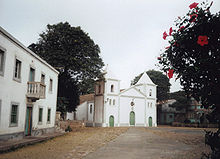Vila Nova Sintra
| Vila Nova Sintra | ||
|---|---|---|
|
|
||
| Coordinates | 14 ° 53 ′ N , 24 ° 41 ′ W | |
| Basic data | ||
| Country | Cape Verde | |
|
Archipelago |
Ilhas de Sotavento | |
| District | Brava | |
| ISO 3166-2 | CV-BR | |
| height | 500 m | |
| Residents | 1536 (2010) | |
|
Vila Nova Sintra seen from a viewpoint above the city
|
||
Vila Nova Sintra is the capital of the island of Brava in the island republic of Cape Verde and with 1536 inhabitants (status: 2010 census) it is by far the largest settlement on the island. That is about a fifth of all of Brava's residents.
geography
The island's capital is located in the mountainous highlands of Bravas at an altitude of around 500 meters above sea level . It can only be reached from outside via the port of the fishing village Furna . Both places are connected by two roads, of which only one is suitable for vehicle traffic with a journey time of about a quarter of an hour. Due to the altitude and the fact that passing clouds often get stuck on the mountain range, the temperature in the urban area is usually slightly lower than is to be expected in the tropics .
The cityscape of Vila Nova Sintra is characterized by the green of the plants and exudes calm cosiness. Streets and squares mostly offer a lot of space for trees. The majority of the main streets are laid out as avenues. Narrow streets and alleys are limited to a few residential areas. The central square of the city is Praça Eugénio Tavares , which is adorned with numerous flower beds. The wide avenues of Vila Nova Sintras run towards this square from all four directions. It is named after the famous Cape Verdean musician Eugénio Tavares , who is considered to be the master of Morna music, which is typical of Cape Verde . In the square there is a pavilion for musical performances.
History and naming
The name of the city is based on the royal summer residence Sintra in Portugal . The small town was a popular travel destination in the 18th and 19th centuries, especially in summer, where the aristocrats and colonial officials from the Cape Verdean main island of Santiago stayed. It is thanks to the investments that the attractive cityscape has been able to hold up to the present day. In the past, many of the residents had temporarily emigrated to America for economic reasons and, when they returned to their home island, used their money to restore and renovate the beautiful old houses. The local government of the island ensures today that this historical image of the city is preserved in the future. So it was ordered that new buildings on the island of Brava and especially in Vila Nova Sintra have to match the old colonial style houses .
Attractions
- Eugénio Tavares' former home is at the end of Rua da Cultura , where many well-preserved examples of Portuguese colonial architecture can be seen. Today it is a museum and a memorial was erected next to it.
- Vila Nova Sintra has six churches. The Catholic Church São Jão Baptista , a little east of the Praça in a side street, was built around 1870 in a relatively unadorned style with two towers. The evangelical Igreja do Nazareno from the community of the Church of the Nazarenes at Praça Eugénio Tavares was founded in the first half of the 20th century by missionaries who returned from the United States.
- At the eastern entrance to the village, a viewpoint in the shape of a ship was built - the Santa Maria , with which Columbus discovered America in 1492. From here there is a beautiful view over the neighboring settlement of Santa Bárbara to the coast to the neighboring island of Fogo . A similar monument in the shape of a ship can be seen in the small village of Campo Baixo in the south of the island of Brava.
- Impressive specimens of the now rare dragon tree ( Dracaena draco , port .: dragoeiro ) grow in various parts of the city . B. near the school on Rua da Cultura and near the Praça.
Surroundings
Vila Nova Sintra is surrounded by the following settlements:
literature
- Pitt Reitmaier, Lucete Fortes: Travel Guide Cabo Verde - Cape Verde Islands . Ed .: Reise Know How. Reise Know How, Bielefeld 2013, ISBN 978-3-8317-2359-1 , Insel Brava, p. 178-195 .
- Susanne Lipps, Oliver Breda: Travel Atlas Cape Verde Islands . Ed .: Dumont. Dumont, Ostfildern 2005, ISBN 3-7701-5968-3 , Insel Brava, p. 153-156 .
Individual evidence
- ↑ INE - CENSO 2010. ( Memento of the original from April 9, 2014 in the Internet Archive ) Info: The archive link was inserted automatically and has not yet been checked. Please check the original and archive link according to the instructions and then remove this notice. In: Portal do Instituto Nacional de Estatística (website), Brava ( Memento of the original from September 5, 2014 in the Internet Archive ) Info: The archive link was inserted automatically and has not yet been checked. Please check the original and archive link according to the instructions and then remove this notice. (XLS document).
- ↑ a b Cape Verde Islands. Dumont travel paperback, 3rd edition, 2007, ISBN 3-7701-5968-3 .
- ↑ Susanne Lipps: Cape Verde Islands , p. 272. Ostfildern 2009.
- ↑ Manuel Brito-Semedo: Uma Visão Antropológica da Igreja do Nazareno de Cabo Verde - Part II. In: Brito-Semedo.blogs.sapo.cv , November 9, 2012; Marilyn Halter: Between Race and Ethnicity. Cape Verdean American Immigrants, 1860-1965. University of Illinois Press, Urbana 1993, ISBN 0-252-01997-0 , p. 149 .




